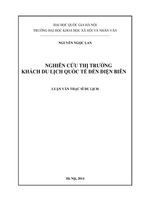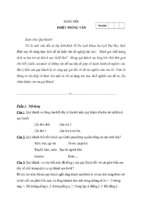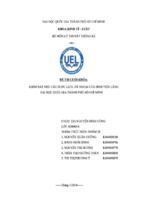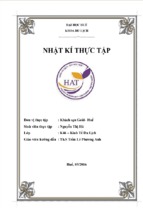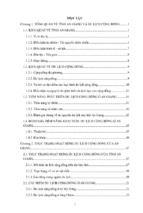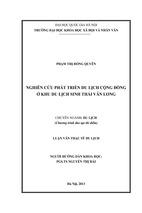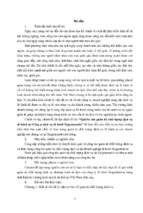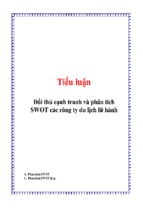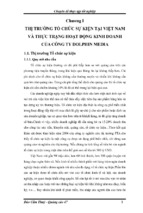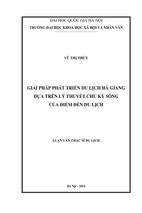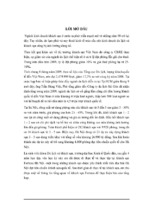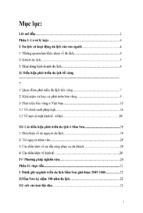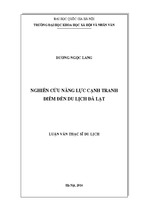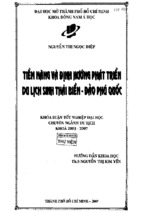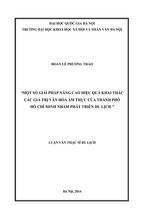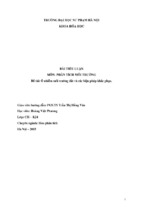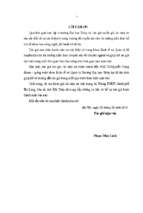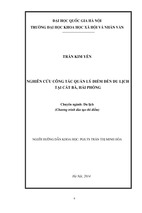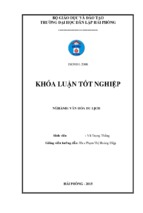BÁO CÁO TỐT NGHIỆP
Đề tài
Phân tích một số yếu tố ảnh hưởng đến cường độ nén nở hông
của cọc xi măng đất tại công trình đường liên cảng Cái Mép –
Thị Vải và đánh giá hiệu quả của phụ gia muội silic.
ĐẠI HỌC QUỐC GIA TP.HCM
CỘNG HOÀ XÃ HỘI CHỦ NGHĨA VIỆT NAM
TRƯỜNG ĐẠI HỌC BÁCH KHOA
Độc lập – Tự do – Hạnh phúc
TP. Hồ Chí Minh, ngày ….. tháng ….. năm ……
NHIỆM VỤ LUẬN VĂN TỐT NGHIỆP
Khoa: Kỹ thuật Địa Chất và Dầu Khí
Bộ môn: Địa Kỹ Thuật
Họ và tên: NGUYỄN VĂN CƯỜNG
MSSV: 30600264
Chuyên nghành: ĐỊA KỸ THUẬT
Lớp: DC06KT
1. Đề tài luận văn:
FACTORS AFFECT ON UNCONFINED COMPRESSIVE STRENGTH OF
SOIL CEMENT COLUMN IN THI VAI – CAI MEP INTER-PORT ROAD AND
ASSESSING EFFECT OF SILICA FUME ADMIXTURE
2. Nhiệm vụ luận văn:
-
Tiến hành trộn, bảo dưỡng, nén mẫu xi măng đất trong phòng thí nghiệm.
-
Tổng hợp, thống kê, phân tích kết quả thí nghiệm, thiết lập biểu đồ thể hiện các
mối tương quan, đánh giá kết quả thí nghiệm.
-
Tiến hành so sánh sự khác biệt giữa cường độ cọc đất xi măng thực tế so với
mẫu trộn trong phòng thí nghiệm.
-
Trình bày, luận giải các yếu tố ảnh hưởng đến cường độ cọc xi măng đất.
3. Ngày giao nhiệm vụ luận văn: 01/08/2010
4. Ngày hoàn thành luận văn: 30/12/2010
5. Cán bộ hướng dẫn: ThS. Nguyễn Thanh Nhàn, TS Nguyễn Minh Trung.
CÁN BỘ HƯỚNG DẪN 1
CÁN BỘ HƯỚNG DẪN 2
(Ký và ghi rõ họ tên)
(Ký và ghi rõ họ tên)
Nội dung và yêu cầu của luận văn đã được thông qua bộ môn
Ngày ….. tháng ….. năm 20…
CHỦ NHIỆM BỘ MÔN
(Ký và ghi rõ họ tên)
ACKNOWLEDGEMENT
And there come a day when I do graduated thesis, still there be joyful to get
graduation. The helps and continuous supports from teachers, friends, and family
whom I am most grateful make me mature. Without you, all of you, I don’t know who
I am today. I would like to thank each of you individually by word, but also I do in my
heart.
I would like to express my deepest gratitude to my supervisor, MSc. Nguyen
Thanh Nhan and Dr. Nguyen Minh Trung, with a spirit of enterprise for his strong
support and whole-hearted guidance, encouragement and advice in this study.
Especially, MSc Nguyen Thanh Nhan, I don’t forget the time when he spent with me
in numerous discussions in this research. His rich knowledge in the geotechnical
engineering has also been most helpful in guiding this study. I have learned a lot from
his thorough and insightful review of this research and his dedication to producing
high quality. In additional, he made me many opportunities to practice. Then I could
directly practice almost theory which I had studied. He made considerable contribution
to my project.
During the time I study, I received helping from all teachers in my department,
especially Dr. Phan Thi San Ha. She helped me to understand clay minerals,
pozzolanic reaction and many problems in geotechnics. My friends, my brothers
helped me to do my graduation thesis enthusiastically. I am grateful to all of you.
Doing this project helped me improve my knowledge of major English very
much. With me, English is very important when I work in the future. Although I tried
my best to finish my graduation thesis in English language, I think it still had many
mistakes. I wish I will receive many contributions of you.
Best regards.
Nguyen Van Cuong
i
TÓM TẮT
Đề tài LVTN: “Phân tích một số yếu tố ảnh hưởng đến cường độ nén nở hông của cọc
xi măng đất tại công trình đường liên cảng Cái Mép – Thị Vải và đánh giá hiệu quả
của phụ gia muội silic.”
Tuyến đường liên cảng Cái Mép – Thị Vải nối liền hệ thống cảng và các khu
công nghiệp chạy dọc sông Cái Mép - Thị Vải với tổng vốn đầu tư 6300 tỉ đồng. Hiện
đang thi công đoạn số 3 (từ km 7 + 199 – km 9 + 612). Vị trí công trình nằm trên khu
vực đất yếu thuộc trầm trích sông biển hỗn hợp có tính chất phức tạp. Do đó để đảm
bảo khả năng khai thác của tuyến đường tải trọng cao đòi hỏi phải có một giải pháp
nền móng hợp lý và kinh tế. Với những ưu điểm trong công tác xử lý nền đất yếu,
công nghệ cột xi măng đất được xem như giải pháp tối ưu cần phải được xem xét và
ứng dụng rộng rãi.
Để góp phần thực hiện điều này, trong luận văn này tác giả đã tập trung vào
nghiên cứu các vấn đề sau:
-
Tìm hiểu cơ sở lý thuyết của phương pháp cọc xi măng đất.
-
Tiến hành trộn mẫu trong phòng để phân tích một số yếu tố ảnh hưởng
đến cường độ nén nở hông, đánh giá hiệu quả của phụ gia muội silic và
đưa ra hàm lượng tối ưu.
-
Nghiên cứu ảnh hưởng của môi trường xung quanh:
• Chịu ảnh hưởng của nước (điều kiện nước ngầm)
• Sự thay đổi hàm lượng muối trong đất.
• Môi trường đất tự nhiên xung quanh cọc
-
So sánh sự khác biệt giữa cường độ cọc đất xi măng thực tế so với mẫu
trộn trong phòng thí nghiệm.
ii
ABSTRACT
The graduation thesis: “Factors affect on unconfined compressive strength of
soil cement column in Thi Vai – Cai Mep inter-port road and assessing effect of silica
fume admixture.”
The Cai Mep-Thi Vai inter-port road system connects to the ports system and
industrial zones along the Cai Mep - Thi Vai River, total of initial investment equals
6300 billions VND. The component project No.3 (Km 7+199 to Km 9+612) is being
executed at present. The construction is located on weak soil foundation of near shore
marine – alluvial deposit which has complex properties. Therefore, to ensure the
effectively using of the super-weight construction needs to have a reasonable and
economical geological solution. With the specific advantage in weak soil foundation
treatment, the soil cement column is considered a most optimal solution needs to
research and apply.
To contribute to execute above matter, in this research (composition), the
author has researched and analyzed some matter as follows:
-
To understand theory of soil cement column.
-
Preparing, mixing, testing specimens in laboratory in order to analysis
factors affecting on unconfined compressive strength of soil cement
samples, assessing effect of silica fume admixture and outputting
optimum mixture ratio.
-
Researching effect of curing environment:
• The effect of water to strength of soil cement columns
• The effect of salt content in water to strength of soil cement
columns.
• The effect of natural soil around columns.
-
Research the correlation of unconfined compressive strength between
laboratory mixed specimens and core samples of soil cement columns.
iii
TABLE OF CONTENTS
ACKNOWLEDGEMENT ............................................................................................... i
TÓM TẮT....................................................................................................................... ii
ABSTRACT .................................................................................................................. iii
TABLE OF CONTENTS .............................................................................................. iv
LIST OF FIGURES ..................................................................................................... viii
LIST OF TABLES ....................................................................................................... xii
INTRODUCTION .......................................................................................................... 1
1. General .....................................................................................................................1
2. Purpose and scope of research ................................................................................2
4. Methodology of study ..............................................................................................3
5. Scientific significance of research ...........................................................................5
6. Practical significant of research ...............................................................................5
7. Innovation of the research ........................................................................................5
8. Limitations of research.............................................................................................5
CHAPTER 1: LITERATURE REVIEW........................................................................ 6
1.1 History and application of soil cement column .....................................................6
1.1.1 History .............................................................................................................7
1.1.2 Application.....................................................................................................10
1.1.3 Typical arrangement patterns of soil cement columns ..................................15
1.2 Overview of method of constructions soil cement columns ................................17
1.2.1 Dry Jet Mixing (DJM) ...................................................................................17
1.2.2 Wet Jet Mixing (WJM) ..................................................................................18
1.3 Investigation on reaction in soil cement columns ................................................19
1.3.1 Composition of Portland Cement ..................................................................19
iv
1.3.2 Basic mechanisms of soil cement stabilization .............................................21
1.4 Silica fume admixture ..........................................................................................31
1.4.1 Definition .......................................................................................................31
1.4.2 Silica fume properties and reaction chemical. ...............................................31
1.5 Factors affecting on unconfined compressive strength of soil cement columns. 33
1.5.1 Effects of type, characteristics and Conditions of Soil to be improved ........34
1.5.2 Effect of cement content ................................................................................36
1.5.3 Effect of water/cement ratio ..........................................................................38
1.5.4 Effect of mixing condition .............................................................................40
1.5.5 Curing condition ............................................................................................44
1.6 The correlation between strength and strain ........................................................48
1.7 Summary ..............................................................................................................52
CHAPTER 2: THE TESTING METHODS IN LABORATORY ............................... 53
2.1 Soil Characterization ............................................................................................53
2.1.1 Moisture Content (ASTM D 2216-98 and ASTM D 4643-00) .....................53
2.1.2 Particle Size Distribution (ASTM D 422-63) ................................................53
2.1.3 Atterberg Limits (ASTM D 4318-00) ...........................................................53
2.1.4 Classification (ASTM D 2478-00) ................................................................54
2.1.5 Organic Content (ASTM D 2974-00) ............................................................54
2.1.6 Specific Gravity (ASTM D 854-00) ..............................................................54
2.1.7 pH (ASTM D 4972-01) .................................................................................54
2.1.8 Sulfate Content (AASHTO T290-95)............................................................54
2.1.9 Mineralogical Analysis ..................................................................................55
2.2 Laboratory of Research Variables, Defining related parameter and volume of
research. .....................................................................................................................55
2.2.1 Laboratory of Research Variables .................................................................55
2.2.2 Specimen Notation........................................................................................56
v
2.2.3 Defining related parameter ............................................................................56
2.3 Preparing for Laboratory research .......................................................................57
2.3.1 Location of soil sample use to test and method of sample taking .................57
2.3.2 Necessary equipments ...................................................................................57
2.4 Preparing, Curing specimens (JGS 0821-2000) ...................................................59
2.4.1 Preparing specimens. .....................................................................................59
2.4.2 Curing specimens...........................................................................................60
2.4.3 Unconfined compressive strength test (ASTM D 2166-00) ..........................62
2.5 Summary ..............................................................................................................64
CHAPTER 3 THE FACTORS AFFECT ON UNCONFINED COMPRESSIVE
STRENGTH OF SOIL CEMENT COLUMNS .......................................................... 64
3.1 General introduction of Cai Mep - Thi Vai inter-port route project ..................64
3.1.1 Soil Characterization .....................................................................................66
3.2 Analysis and valuation of test results in Laboratory ............................................70
3.2.1 The correlation between unconfined compressive strength and cement
content .....................................................................................................................70
3.2.2 Effect of water/cement ratio to unconfined compressive strength ................73
3.2.3 Effect of Silica fume/cement ratio to unconfined compressive strength when
cement content equals 220 kg/m3, water/cement ratio equals 0.7. .........................76
3.2.4 Effect of curing time to unconfined compressive strength ............................79
3.2.5 Effect of curing environment to unconfined compressive strength...............82
3.3 Analysis and valuation of test results core sampling from soil cement columns 85
3.3.1 Affecting of cement content ..........................................................................85
3.3.2 The correlation between UCS and Water/ cement ratio ................................86
3.3.3 Correlation between stress and strain ............................................................88
3.4 Comparison between strength of specimens is mixed in LAB and FIELD .........88
vi
CONCLUSIONS AND RECOMMENDATIONS ....................................................... 95
AREAS FOR FUTURE RESEARCH .......................................................................... 97
REFERENCES ............................................................................................................. 98
APPENDIXES ............................................................................................................ 101
vii
LIST OF FIGURES
Figure 1.1: Picture illustrates some applications of soil-cement column ................................. 10
Figure 1.2: DMM used for liquefaction control and seepage cut off. Jackson Lake Dam, WY
(Taki and Yang, 1991) .............................................................................................................. 11
Figure 1.3: a) Prevention of sliding failure for high banking ................................................... 12
Figure 1.4: c) Stability of excavated slope gradient ................................................................. 12
Figure 1.5: Soil Cement Excavation Support Wall .................................................................. 13
Figure 1.6: Proposed classification of DSM application .......................................................... 14
Figure 1.7: Soil cement columns use for land and marine projects .......................................... 15
Figure 1.8: Different configuration of DSM columns .............................................................. 16
Figure 1.9: Line-up of Dry Jet Mixing system (www.raito.co.jp, 2006).................................. 18
Figure 1.10: Dry mixing method: (a) on board binder silo, (b) Separate binder silo (Roslan
Hashim and Md. Shahidul Islam, 2008) ................................................................................... 18
Figure 1.11: Line-up of Wet Jet Mixing system (www.raito.co.jp, 2006) ............................... 19
Figure 1.12: Deep wet mixing plant with (a) on board binder silo, (b) separate binder silo
(Roslan Hashim and Md. Shahidul Islam, 2008) ..................................................................... 19
Figure 1.13: A pictorial representation of a cross-section of a cement grain. Adapted from
Cement Microscope, Halliburton Services, Duncan. ............................................................... 21
Figure 1.14: Chemical reactions between cement, Silica fume, clay and water (Saitoh et al,
1985; edit by Nguyen Van Cuong 2010) .................................................................................. 22
Figure 1.15: Picture illustrate soil cement structure ................................................................. 23
Figure 1.16: The basic molecular and structural components of silicate clays. ....................... 25
Figure 1.17: Structure of clay mineral ...................................................................................... 26
Figure 1.18: The concept of the diffuse double layer (from Das 1997) ................................... 27
Figure 1.19: Forming C-S-H on pozzolanic reaction of soil cement stabilization cured for
about 300days ........................................................................................................................... 29
Figure 1.20: As-produced silica fume ...................................................................................... 31
viii
Figure 1.21: Influence of soil pH on strength of binder treated soil ........................................ 34
Figure 1.22: Effect of organic content on the unconfined compressive strength of peat soils. 35
Figure 1.23: Effect of soil type on 7-day unconfined compressive strength of cement
stabilized soil (Taki and Yang 2003)........................................................................................ 36
Figure 1.24: General relationship between binder content and strength gaih (Janz and
Johansson 2002) ....................................................................................................................... 37
Figure 1.25: Laboratory mixes test results with Viet Nam Mekong Delta Clay ...................... 37
Figure 1.26: Relationship between cement content and unconfined compressive strength for
cement treat various soils: a) by Mitchell 1976; b) by Huat et al 2006 .................................... 38
Figure 1.27: Schematic of cement admixed clay skeleton showing the effect of total water
content ...................................................................................................................................... 39
Figure 1.28: Effect of penetration rate on strength for a given total clay water to binder ratio
(Horpibulsuk et al. 2004) .......................................................................................................... 41
Figure 1.29: Relationship between strength and consumed energy in soil-quicklime mixing . 42
Figure 1.30: Types of mixing blades (a) Type A-1; (b) Type A-2; (c) Type B-1; and (d) Type
B-2 (Dong et al. (2006)) ........................................................................................................... 43
Figure 1.31: Relationship between rotary speed and improved strength (Dong et al. 1996) ... 44
Figure 1.32: Relative between Curing temperature and UCS at 28 days age (Jacobson 2001)
.................................................................................................................................................. 45
Figure 1.33: Effect of curing time on strength for cement contents (Horpibulsuk et al. 2003) 46
Figure 1.34: UCS of soil cement with curing time (Supakij et al. of Kasetsart University) ... 46
Figure 1.35: Strength development with time of cement-admixed .......................................... 48
Figure 1.36: Relationship between axial strain and lateral strain in unconfined compressive
strength test ............................................................................................................................... 49
Figure 1.37: Relationship between stress and strain when compressing and unloading. ......... 50
Figure 1.38: Elastic modulus of materials: Initial Tangent, Tangent and secant Modulus
(Rasht, I.R. IRAN et al) ............................................................................................................ 51
Figure 1.39: Factors effect of relationship between Axial stress and strain of soil cement
columns a) Time curing; b) water content (After Sudath and Thompson, 1975)..................... 52
ix
Figure 2.1: Phases diagram of mixture element, natural soil, cement binder (Filz et al, 2005)
.................................................................................................................................................. 57
Figure 2.2: a) Mixer; b) Casting mold is oiled bearings ........................................................... 58
Figure 2.3: Push rod of sample ................................................................................................. 59
Figure 2.4: Mixing process ....................................................................................................... 60
Figure 2.5: a) the molds are stripped out; b) Specimens after stripped out .............................. 61
Figure 2.6: Different curing environment................................................................................. 62
Figure 2.7: Unconfined compressive strength testing machine ................................................ 63
Figure 2.8: Affecting of strain rate on UCS a) 8.7 % cement content; b) 12% cement content
(Nguyen Thanh Nhan et al, 2010) ............................................................................................ 64
Figure 3.3: The correlation between UCS and Cement content at 28 days, w:c = 0.71 ........... 70
Figure 3.2: The correlation between UCS and Cement content at 60 days, w:c = 0.7 ............. 70
Figure 3.4: The correlation between UCS and Cement content at 28 days, w:c = 0.8 ............. 71
Figure 3.6: The correlation between UCS and Cement content at 28 days, w:c = 0.9 ............. 72
Figure 3.7: The correlation between UCS and Cement content at 60 days, w:c = 0.9 ............. 72
Figure 3.8: The correlation between UCS and Cement content at 28 days, cement content =
220 kg/m3.................................................................................................................................. 73
Figure 3.9: The correlation between UCS and Cement content at 60 days, cement content =
220 kg/m3.................................................................................................................................. 73
Figure 3.10: The correlation between UCS and Cement content at 28 days, cement content =
240 kg/m3.................................................................................................................................. 74
Figure 3.11: The correlation between UCS and Cement content at 60 days, cement content =
240 kg/m3.................................................................................................................................. 74
Figure 3.12: The correlation between UCS and Cement content at 28 days, cement content =
260 kg/m3.................................................................................................................................. 75
Figure 3.13: The correlation between UCS and Cement content at 60 days, cement content =
260 kg/m3.................................................................................................................................. 75
Figure 3.14: The correlation between UCS and silica fume/cement ratio at 7 days ................ 76
Figure 3.15: The correlation between UCS and silica fume/cement ratio at 14 days .............. 76
x
Figure 3.16: The correlation between UCS and silica fume/cement ratio at 28 days .............. 77
Figure 3.17: The correlation between UCS and silica fume/cement ratio at 60 days .............. 77
Figure 3.18: The correlation between UCS and time at soil environment ............................... 79
Figure 3.19: The correlation between UCS and time at NaCl 2.5 % environment .................. 79
Figure 3.20: The correlation between UCS and time at NaCl 5 % environment ..................... 80
Figure 3.21: The correlation between UCS and time city water environment ......................... 80
Figure 3.22: The correlation between USC and time ............................................................... 82
Figure 3.23: The correlation between USC and time ............................................................... 82
c) City water environment d) NaCl 2.5 % environment Figure 3.24 SEM photograph (MSc
graduation thesis of Nguyen Thanh Dat, HCMUT, 2010) ....................................................... 83
Figure 3.25: The correlation between USC and cement content, water/cement = 0.7 ............. 85
Figure 3.26: The correlation between USC and cement content, water/cement = 0.8 ............. 85
Figure 3.27: The correlation between USC and cement content, water/cement = 0.9 ............. 86
Figure 3.28: The correlation between USC and water/cement, cement content = 220 kg/m3 86
Figure 3.29: The correlation between USC and water/cement, cement content = 240 kg/m3 87
Figure 3.30: The correlation between USC and water/cement, cement content = 260 kg/m3 87
Figure 3.31: The correlation between UCS and Strain at 28 days ........................................... 88
Figure 3.32: Comparison between strength of specimens mix in LAB and FIELD ................ 91
Figure 3.33: Operators Cabin For High Performance Quality Control (Photographic image
from research of Ulli Wiedemann, Germany) .......................................................................... 94
xi
LIST OF TABLES
Table 1.1 Deep Mixing Acronyms and Terminology (After Porbaha, 1998) ............................ 6
Table 1.2 Complementary information on research project has recently been provided by
porbaha (1998)............................................................................................................................ 7
Table 1.3 Chemical composition .............................................................................................. 20
Table 1.4 Crystal composition .................................................................................................. 20
Table 1.5 Mechanisms Contributing to Cement Stabilization of Soil Materials ...................... 30
Table 1.6 Chemical Properties of Silica fume .......................................................................... 32
Table 1.7 Factor affecting the strength increase ( Terashi, 1997) ............................................ 33
Table 1.8: Installation parameter for DSM column (Shen et al. 2005) .................................... 43
Table 1.9: The correlation between curing time and U.C.S ..................................................... 47
Table 2.1 presents variables studied in the present investigation. ............................................ 55
Table 2.2: Summary of the sample notation ............................................................................. 56
Table 3.1: Summary of Soil Characterization .......................................................................... 66
Table 3.2: Summary of chemical composition ......................................................................... 66
Table 3.3, Comparison of UCS between specimens use silica fume and no using silica fume.
.................................................................................................................................................. 78
Table 3.4: To compare unconfined compressive strength at 7 days, 14 days, 6 days with 28
days when w/c = 0.7. ................................................................................................................ 81
xii
“Introduction”
INTRODUCTION
1. General
In recent years, out country is entering the period of industrialization and
modernization. National economy is more and more growing nowadays. The growing
demand of centralizing industrial parks, expanding markets, urban infrastructure
rehabilitations and new urban developments, highways, sports, etc have created very
active. The constructions are usually concentrated in places where convenient
economic condition and traffic, but engineering geological condition is unfavorable
such as Mekong river delta, Ho Chi Minh City, Can Gio, some where in Baria - Vung
Tau province, etc. Here, geologic structure is complex, including many layers of soft
soil. It is large and different thickness, surface distribution. The characteristics of soft
soil are most of all: low shear strength, high compressibility and low permeability,
which create difficulties in the design and construction over it.
The task of geotechnics and civil engineers find different methods to treat soft
soil foundation such as: prefabricated concrete pile, sand pile, sand well, geotechnical
material (vertical artificial drain, geotextile fabric),… Each of methods has specific
strengths and weaknesses. When construction will have been built, engineers often
select method to improve soft soil very difficultly, especially super-weight of
constructions. The most suitable method for each project is usually selected
considering technical quality and economical benefit. Prefabricated concrete pile is
high strength but expensive, vertical artificial drain may be break, time-long
construction. Depend on each of projects, they maybe not economical and
technological.
The way of solving that problem, people tried applying improvement of soft soil
by soil-cement column in many countries. This method has been applied in the world
for a long time, but it has been approached newly in Viet Nam. So that, the researches
about this method in Vietnam hasn’t been much, especially with concrete ground
areas. The research of Nozu,M in Fudo Construction Co. Ltd, Japan showed that the
1
“Introduction”
soil cement column method is considered to be more suitable than vertical drain
method. The strength of soil cement column depend on many factors.
This study will research in Cai Mep – Thi Vai International Port Zone in Ba Ria
– Vung Tau province where soil salinity (soil salinity is the salt content in the soil) and
high organic content. Recently, the research for soil salinity showed following:
With soil salinity, when low level of salt in the soil (<0.3%) isn’t affect on
soil characteristics. However, level of salt in the soils is higher than 0.3%, soil
characteristics are noticeable chance. Research results for Binh Thuan clay
showed that soil inner friction angle decrease 4 degree, soil cohesion decrease
around 0.5 time when soil salinity increase from 0-1%. (MSc graduation
thesis of Ly Huynh Anh Ly, HCMUT,2007)
So that, research for affecting by soil salinity, soil pH and water environment
around soil-cement column on strength of soil-cement column is necessary. Thence,
application of soil-cement columns achieves higher effect when stabilizing soft soil in
Cai Mep – Thi Vai International Port Zone.
2. Purpose and scope of research
The main goal of this research understand particular detail of factors affect on
unconfined compression strength of soil-cement stabilization method in Thi Vai – Cai
Mep internal road and assessment of the affect by silica fume admixture.
This graduation thesis includes 4 chapters, which were summarized as follows:
The opening chapter, student introduced urgency of the research. To explain
purpose and scope of this research. To show methodology, innovation and
limitations of the research.
Chapter 1: Basing on literature review, author presented the general working
of soil-cement column to improve the soft soil. Author described briefly the
factors affecting on unconfined compression strength of soil-cement column.
To find out using for admixture for increase strength of soil-cement columns.
The main purpose of chapter 2 focus on describing soil testing, methods of
making, curing specimens and testing unconfined compression strength
2
“Introduction”
specimens of soil-cement columns in laboratory. Specimens are made of
different cement content, water/cement ratio, silica fume/cement ratio and it is
cured on different environment.
Chapter 3: Summarizing, analyzing and comparing test results on specimens
from Lab and Field. Assessing effect of silica fume admixture.
The end chapter summarized the previous chapters and showed the final
conclusions and future works.
4. Methodology of study
Research on theory:
Theoretical basic of reaction in soil-cement mixtures for unconfined
compressive strength gain of soil cement column.
Experimental research:
Test on physical-mechanical properties of undisturbed soil.
Author tested unconfined compressive strength of field mixed and
laboratory mixed specimens.
Basing on test result author summarized, analyzed and compared test
results on specimens from laboratory mixed specimens and core sample
of soil cement column.
3
“Introduction”
Task 1
Literature review
Task 3
Laboratory studies simulating soil-cement columns
Task 2
Site selection and
characterization of soils
Task 4
USC test on specimens and
interpretation of the data
Task 5
Summarizing and expressing
data by chart
Task 7
Task 6
Comparison of field and
analyzing the chart
Literature review for
Silicate chemistry
Task 8
Explaining test result
Summary, conclusions and future
research recommendation
Figure 0.1: Schematic of tasks performed in this research
4
“Introduction”
5. Scientific significance of research
Author defined factors affect on unconfined compression strength of soilcement column. Assessing effect of silica fume admixture.
6. Practical significant of research
Determining optimal ratio of binder, water/cement ratio for Thi Vai -Cai Mep
Inter-port road project. Besides, applying the test result to pre-design projects, which
use silica fume admixture for soil cement column.
7. Innovation of the research
This study is practiced at concrete ground areas (littoral – alluvial deposit of
Thi Vai – Cai Mep inter-port road, Ba Ria –Vung Tau province).
Scope of the study include 4 curing environments, 3 cement contents,
3
water/cement ratio, 3 admixture ratio.
Formation of USC strength is explained by combining of test result in
laboratory, in field and terms of silicate chemistry.
8. Limitations of research
The research performed a short-time (60 days), so that the result didn’t show
clearly to affect of curing environment, silica fume admixture.
The research only examined unconfined compressive strength test. It was not
mentioned to direct shear test, unconsolidated undrained test. There are many factors
affect on unconfined compressive strength of soil-cement column but this research
only examining some factors following: cement content, water/ cement ratio, silica
fume/cement ratio, curing environment, curing time.
5
- Xem thêm -

